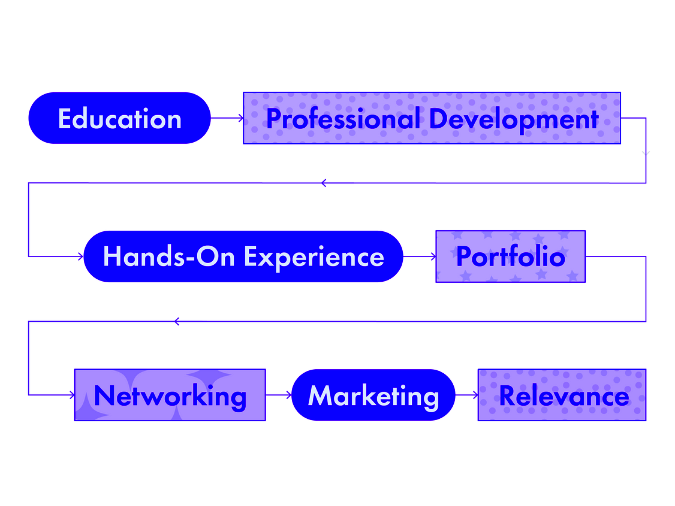Being a UX researcher may sound like a role but at its core it revolves around grasping human behavior. When I initially came across UX research I assumed it was solely focused on statistics and figures. However as I explored further I discovered that it's primarily about paying attention. Paying attention to users, comprehending their challenges and discovering ways to enhance their overall experience. It's akin to being a detective specifically in the realm of technology.
In a freelance environment this position takes on a flair. As a UX researcher you’re not limited to a single company. Instead you collaborate with diverse clients, each catering to their own distinct audience. Every project brings the thrill of delving into user behavior and generating insights that can enhance design. It’s not merely about posing queries but rather asking the ones that reveal significant trends.
Developing Essential Skills for UX Research

When I first delved into UX research, I thought it was solely about going through reports and offering suggestions. However, the reality is that a combination of skills is crucial for success. If I were to outline the key elements, here’s how I would begin.
- Empathy: You have to put yourself in the user's shoes. Understand their frustrations, their joys, and everything in between.
- Communication: Explaining your findings to clients who might not have a technical background is key. A great idea means nothing if it’s not conveyed well.
- Data Analysis: You need to be comfortable with numbers. Data can tell you a lot about how users behave and what they need.
- Interviewing: Talking to users and getting them to open up is an art. I found that just being genuine and curious works wonders.
- Tool Familiarity: From survey platforms to analytics tools, there are many resources that make a UX researcher's life easier.
When I first began I didn't realize just how much of this job was about hands on learning. As time goes on you acquire these abilities not through books but through the little everyday experiences that show you what truly counts.
Also Read This: How to Become a Seller on Fiverr
Building Your Portfolio as a Freelance UX Researcher

This is where I faced my greatest challenge. How can you highlight your skills when much of your work happens in the background? But here’s the insight I gained – your portfolio doesn’t need to be extravagant. It simply needs to be genuine.
Begin by delving into studies. Even if you're a beginner consider taking on some projects. Perhaps you could offer your assistance to a nearby company or nonprofit organization. Document your journey detailing how you tackled the challenge the research techniques you employed and the results you achieved.
I once assisted a buddy in revamping her blog. While it wasn't an undertaking I approached it with utmost dedication. I documented the process of interviewing her audience, assessing their input and suggesting subtle adjustments. That project ended up in my portfolio and surprisingly played a role in securing me a job opportunity down the line.
A few things to include in your portfolio:
- Project Overview: Briefly explain the problem you were solving.
- Research Methods: Mention whether you used interviews, surveys, usability testing, or analytics.
- Results: Highlight what changed after your research and why it was impactful.
Its not about proving your perfection but rather demonstrating your thinking process and showcasing how you can assist clients in gaining a clearer understanding of their users. With each project you undertake you will gradually strengthen and enhance your portfolio making it more compelling over time.
Also Read This: How Do I Add a Credit Card on Fiverr?
Finding Freelance UX Research Jobs Online
Oh the hunt for freelance opportunities! It’s both thrilling and a bit stressful dont you think? I recall my initial experience with freelancing. The idea of securing a stream of clients seemed daunting. However once you grasp the right places to search and the approach to take everything starts to come together smoothly.
Freelance UX researchers have found platforms such as Fiverr and Upwork to be quite useful. They serve as decent starting points. However relying exclusively on them can make it seem like a competition. To avoid that try to diversify your options. Here are some strategies that have proven successful for me,
- Networking: Don’t underestimate the power of LinkedIn. I once connected with someone who liked my post about a small UX project. That connection turned into a long-term client. Be active, share your insights, and engage with others.
- Freelance Platforms: Platforms like Fiverr or Toptal are great for beginners. But remember, competition is tough. You need a strong profile, with clear descriptions of your skills and previous work.
- Cold Emails: Reaching out directly to companies can also work. I crafted personalized emails explaining how I could help improve their user experience, and you’d be surprised how many companies were open to it.
- Job Boards: Sites like We Work Remotely, Remote OK, and AngelList offer freelance positions too. Sometimes, they don’t even advertise them as ‘freelance,’ but once you get your foot in the door, you can negotiate.
Searching for freelance work on the internet requires effort, perseverance and a sprinkle of ingenuity. However once you become familiar with the process you'll discover that the possibilities are boundless.
Also Read This: How to Make Money with Fiverr: A YouTuber’s Guide
Setting Your Rates and Managing Finances
Discussing finances can be quite awkward, particularly in the stages. I recall the moment a client inquired about my fees I went into a frenzy! Am I asking for too much? Not enough? However determining your charges hinges on recognizing your worth and gauging what the market can handle.
When setting rates, consider these factors:
- Your Experience: If you're just starting out, you may need to charge lower rates to build your portfolio. But don’t sell yourself short.
- Project Complexity: Is it a quick usability test or a full-blown research project? The more complex, the higher the rate should be.
- Market Rates: I made it a habit to research what other UX researchers were charging. Sites like Glassdoor or freelance forums gave me a sense of the average.
- Client Budget: Sometimes, clients have tight budgets. I used to offer tiered pricing – basic, standard, and premium packages – to give them options without compromising on my worth.
Handling money matters is a whole different challenge. I realized through experience that staying organized is key. Make sure to keep a record of your bills set aside funds for taxes and always have some extra savings for those quieter months. While software like QuickBooks can assist you in keeping everything in check sometimes a basic spreadsheet works just as well.
Also Read This: What Are the Different Levels on Fiverr?
Marketing Yourself to Potential Clients
I have to admit that promoting yourself can be a bit uncomfortable in the beginning. It’s one thing to promote a product, but when it comes to promoting yourself it’s a whole different story. It took me some time to warm up to the concept. However I came to understand that if you don’t stand up for yourself, who else will?
As a freelance UX researcher, I have gained insights into the world of marketing.
- Be Genuine: Clients appreciate authenticity. Rather than trying to be someone I wasn’t, I focused on my strengths. I’m good at understanding people’s needs, so I highlighted that in my pitches and profiles.
- Build an Online Presence: Your website, LinkedIn, and social media profiles are like your digital business cards. Share your work, write about UX trends, and engage with potential clients. I started by posting simple tips on UX research, and it worked wonders in getting noticed.
- Word of Mouth: Don’t underestimate the power of referrals. Once you do great work for one client, chances are they’ll tell others. I had a client refer me to another company simply because I was transparent and easy to work with. It was a domino effect after that.
- Craft a Compelling Pitch: When reaching out to potential clients, personalize your pitch. Don’t just copy-paste. I always took the time to research the company and suggest specific ways I could help them improve their user experience. It showed that I cared about their business.
Promoting yourself isn’t just about making noise it’s about highlighting what sets you apart and demonstrating your genuine interest. The more relatable you are the more clients will be inclined to collaborate with you.
Also Read This: How to Be Successful on Fiverr: A Comprehensive Guide
Managing Client Expectations and Delivering Quality
Handling what clients expect is quite a balancing act. I’ve come to realize this through experience. When I was starting out as a freelance UX researcher I once assured a client that I could provide insights within a week. I wanted to make a good impression. However midway through the process I discovered that the project was much more extensive than I had anticipated. I had to reconsider my timeline and although the client was understanding it taught me an important lesson – to set realistic expectations right from the beginning.
At the start of every project I make it a point to engage in a candid and transparent discussion with my clients. During this conversation we cover the following topics.
- Scope of the Project: What exactly do they need? Is it a usability study, interviews, surveys, or something else? Clarity upfront saves headaches later.
- Timeline: I’ve started giving a buffer in my deadlines. If I think something will take a week, I’ll say two. That way, if unexpected issues arise, I’m covered, and if I finish early, the client is pleasantly surprised.
- Communication Frequency: Some clients want daily updates, while others prefer weekly summaries. I always ask them what works best for them.
Delivering quality is essential. However quality goes beyond just presenting reports. Its about making sure the research genuinely serves the clients interests. I always strive to communicate my insights in a way using analogies when needed to make them more relatable. Presenting data is one thing but demonstrating how that data can influence their business is a different story altogether.
Also Read This: How to Delete Your Fiverr Account: A Step-by-Step Guide
FAQ About Freelance UX Research
I frequently receive inquiries from clients and budding freelancers regarding UX research and Im more than willing to provide responses. Below are a few of the questions that come up most often.
-
- Q: How do I get started as a freelance UX researcher?
A: Start with small projects. You don’t need a big-name client right away. Help a local business or a friend with a project, and build from there. Having case studies is essential.
-
- Q: Do I need a degree to work as a UX researcher?
A: Not necessarily. While a background in psychology, design, or human-computer interaction helps, many UX researchers are self-taught. What matters more is your understanding of user behavior and research methodologies.
-
- Q: How do I find clients?
A: Freelance platforms like Fiverr are a good start, but don’t stop there. Networking, LinkedIn, and even cold emailing can open doors. Sometimes, it’s as simple as attending industry events and introducing yourself.
-
- Q: How much should I charge?
A: It depends on your experience and the complexity of the project. Beginners might start lower, but always research market rates to ensure you’re charging fairly.
-
- Q: What tools do I need for UX research?
A: There are many, from survey tools like Google Forms to usability testing platforms like UserTesting. Start with free tools if you're new, and invest in more advanced ones as you grow.
Conclusion
Working as a freelance UX researcher is a journey that comes with its share of challenges and rewards. It presents an opportunity to delve into various sectors connect with fascinating individuals and truly influence how users engage with products. However achieving success in this field hinges on staying true to yourself embracing ongoing learning and consistently providing value. When you tackle project with a sincere intention to assist the benefits both personally and professionally, tend to follow suit. Keep in mind that every project serves as a chance for growth and enhancement.




